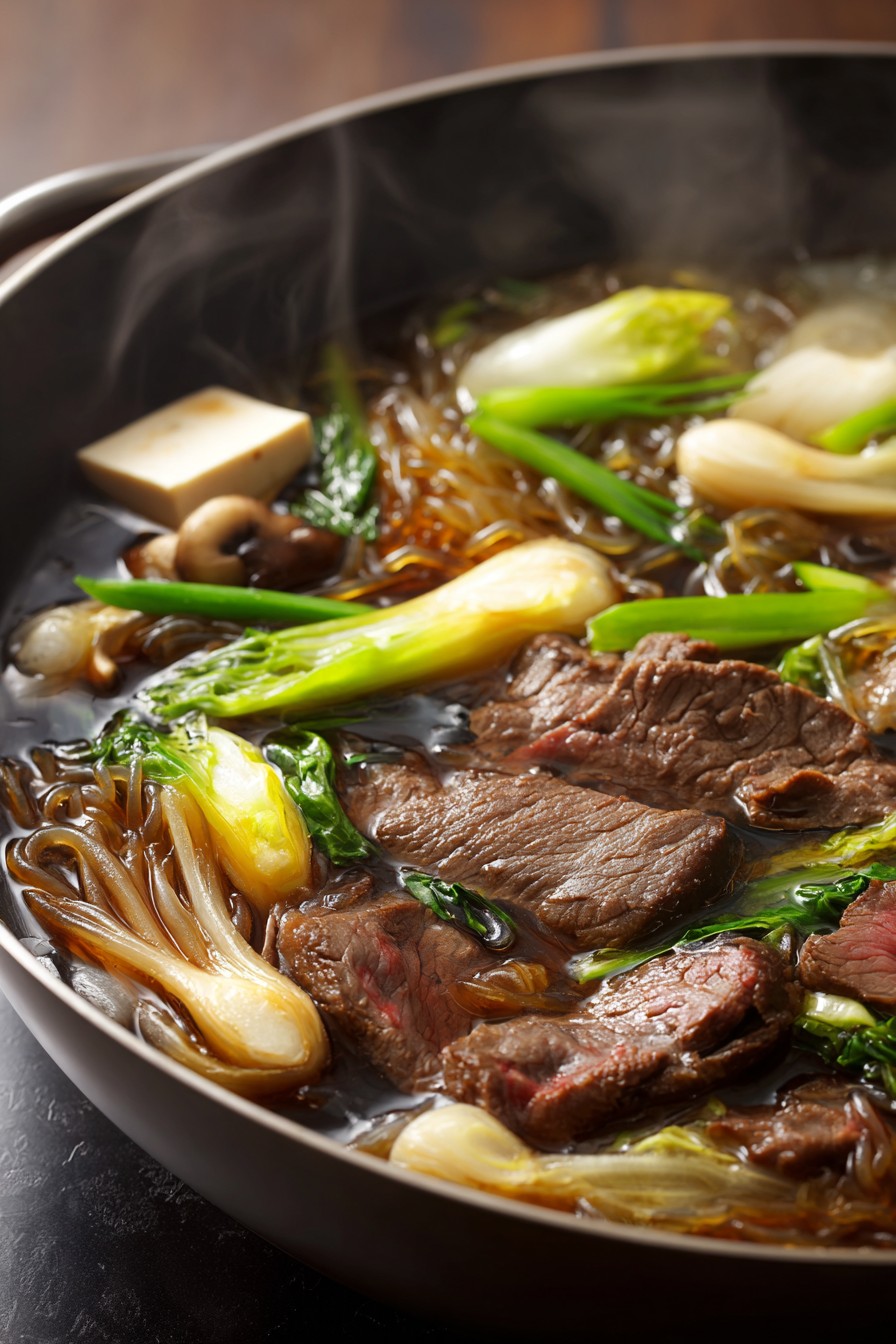Moment by moment, as the sun dips below the horizon and the world settles into a gentle hush, there exists a special kind of magic in sharing a meal that whispers of tradition and tenderness. My heart has always been captivated by the delicate dance of flavors in Japanese cuisine, and this sukiyaki recipe, with its thinly sliced beef bathing in a sweet and savory broth, is my love letter to those quiet, intimate evenings spent with someone special. It’s a dish that invites you to slow down, to savor, and to connect over a shared pot of pure comfort.
Why This Recipe Works
- The use of well-marbled ribeye steak ensures each slice remains incredibly tender and rich, melting effortlessly in the mouth as it simmers gently in the broth, creating a luxurious texture that feels like a warm embrace.
- Our carefully balanced sukiyaki sauce, combining soy sauce, mirin, and sugar, creates a harmonious blend of sweet and savory notes that delicately coat each ingredient without overpowering their natural flavors, resulting in a deeply satisfying and complex taste profile.
- By cooking the ingredients tableside in a single pot, you create an interactive and romantic dining experience where you can watch the vibrant colors of the vegetables soften and the beef transform, making the meal as much about the journey as the destination.
- The inclusion of shirataki noodles and soft tofu adds wonderful textural contrasts to the dish, providing slippery, delicate bites that complement the substantial beef and crisp-tender vegetables perfectly.
- Finishing with a raw egg dip for the cooked ingredients introduces a silky, creamy element that cools each bite just enough while adding another layer of richness, creating a truly sensual eating experience.
Ingredients
- 1 ½ pounds ribeye steak, frozen for 30 minutes then sliced paper-thin against the grain
- 1 large yellow onion, sliced into half-moons
- 4 green onions, cut into 2-inch lengths
- 8 shiitake mushrooms, stems removed
- 1 small napa cabbage, cut into bite-sized pieces
- 1 package shirataki noodles, rinsed and drained
- 1 block soft tofu, cut into 1-inch cubes
- 1 cup soy sauce
- 1 cup mirin
- ½ cup granulated sugar
- 1 cup dashi stock
- 4 large eggs, for dipping
- 2 tablespoons vegetable oil
Equipment Needed
- Large shallow pot or electric skillet
- Sharp chef’s knife
- Cutting board
- Measuring cups and spoons
- Small bowls for serving
- Tongs or cooking chopsticks
- Plates for ingredient preparation
Instructions

Prepare Your Sukiyaki Sauce and Ingredients
Before we begin our culinary dance, let us prepare our stage with care and attention. In a medium bowl, gently combine the soy sauce, mirin, sugar, and dashi stock, whisking until the sugar dissolves completely into the liquid, creating a harmonious blend that will become the soul of our dish. Meanwhile, arrange your sliced ribeye, onion half-moons, green onion pieces, shiitake mushrooms, napa cabbage, shirataki noodles, and tofu cubes on separate plates like artists’ pigments waiting to be blended into a masterpiece. This moment of preparation is where the magic begins, as you anticipate the transformation of these simple ingredients into something extraordinary. Take your time here, feeling the textures beneath your fingers and appreciating the vibrant colors that will soon mingle in the pot.
Create the Flavor Foundation
Place your large shallow pot over medium heat and add the vegetable oil, watching as it shimmers and dances across the surface when properly heated. Carefully add the sliced yellow onion, listening to the gentle sizzle as it meets the warm oil, and cook for approximately 4-5 minutes until the edges begin to turn translucent and release their sweet, aromatic essence into the air. Now, arrange about one-third of your beautifully sliced ribeye in a single layer across the bottom of the pot, letting it sear for just 45-60 seconds until the edges curl slightly and the rich marbling begins to render its glorious fat. The scent that rises from the pot at this moment is pure poetry—the earthy onion mingling with the luxurious beef in a symphony of anticipation.
Build Your Sukiyaki Pot
Pour about one-third of your prepared sukiyaki sauce over the beef and onions, listening to the satisfying sizzle as the liquid meets the hot surface and immediately begins to bubble and reduce. Now, artfully arrange portions of the napa cabbage, shiitake mushrooms, green onions, shirataki noodles, and tofu around the beef, creating a colorful mosaic of ingredients that will cook together in harmony. Cover the pot and let everything simmer gently for 6-8 minutes, until the vegetables have softened but still retain a pleasant texture and the beef has absorbed the sweet-salty essence of the sauce. As you lift the lid, the steam carries with it an intoxicating aroma that promises comfort and connection in every bite.
The Interactive Dining Experience Begins
This is where the true romance of sukiyaki reveals itself—the shared experience of cooking and eating directly from the pot. Using tongs or cooking chopsticks, serve yourself and your companion directly from the simmering vessel, taking care to include a bit of each element in every serving. For the traditional experience, crack a fresh egg into each small bowl and whisk it lightly with chopsticks, then dip each hot morsel into the raw egg before eating, creating a silky coating that enhances the richness while cooling the food to the perfect temperature. The intimacy of this shared pot, the steam rising between you, the gentle clinking of utensils—these are the moments that transform a simple meal into a memory.
Continue the Culinary Conversation
As you enjoy your first servings, the pot continues to work its magic. Add the remaining beef and vegetables in stages, along with more of the sukiyaki sauce, creating successive layers of flavor that evolve throughout your meal. The broth will become increasingly rich and complex with each addition, as the rendered beef fat and vegetable essences mingle with the reducing sauce. This gradual building of flavors means that each serving offers something slightly different, a culinary conversation that develops and deepens as the evening progresses. There’s something profoundly beautiful about a meal that changes and grows alongside your connection with your dining companion.
Savor the Final Moments
Tips and Tricks
For those who wish to elevate their sukiyaki experience to even greater heights, I offer these additional insights gathered from years of perfecting this romantic dish. When selecting your beef, don’t hesitate to ask your butcher to slice it paper-thin for you if you lack confidence in your own knife skills—the professional results are worth the small extra effort and ensure each slice cooks in mere seconds, remaining incredibly tender. If you cannot find traditional shirataki noodles, very thin rice vermicelli makes an excellent substitute, though you’ll want to adjust cooking times slightly as they require less time to become perfectly tender. For those who prefer not to use raw eggs for dipping, a lightly beaten cooked egg can be drizzled over the finished dish, or you might enjoy the textural contrast of togarashi spice blend sprinkled over each bite instead.
The quality of your mirin truly makes a difference in the final flavor profile—seek out hon-mirin rather than mirin-fu condiments, as the authentic version contains alcohol that cooks off while leaving behind a more complex sweetness that cannot be replicated. When arranging your ingredients in the pot, consider the cooking times of each element—placing slower-cooking vegetables like carrots (if using) toward the bottom where they’ll receive more direct heat, while delicate items like enoki mushrooms should be added later to prevent overcooking. If you find your sauce reducing too quickly and becoming overly salty, don’t hesitate to add a splash of additional dashi or even water to maintain the perfect balance throughout your meal.
For those special occasions when you want to make the experience truly unforgettable, consider sourcing wagyu beef instead of ribeye—the incredible marbling will create an even more luxurious, melt-in-your-mouth texture that feels like pure indulgence. If you’re cooking for someone with dietary restrictions, tamari can replace soy sauce for a gluten-free option, and the sugar can be adjusted to taste or substituted with honey for a different nuance of sweetness. Remember that sukiyaki is as much about the experience as the food itself—light some candles, play soft music, and give yourselves permission to linger over each bite, conversing between servings as the flavors continue to develop in your shared pot.
Recipe Variations
- For a seafood-inspired twist that still captures the essence of sukiyaki, replace the beef with large scallops and shrimp, adding them toward the end of cooking to prevent overcooking. The delicate sweetness of seafood pairs beautifully with the sukiyaki sauce, creating a lighter yet equally romantic dish that feels like dining by the ocean. Include additional vegetables like baby bok choy and snow peas to complement the marine elements, and consider using a combination of fish stock and dashi for the cooking liquid to enhance the oceanic notes.
- Create a vegetarian love story by substituting the beef with thick slices of king oyster mushrooms and adding extra firm tofu that has been lightly pan-fried to develop a golden crust. The meaty texture of the mushrooms provides satisfying substance while absorbing the sukiyaki sauce wonderfully. Include a colorful array of seasonal vegetables like eggplant, bell peppers, and sweet potatoes to make the dish visually stunning, and consider adding a tablespoon of miso paste to the sauce for additional umami depth that compensates for the missing beef flavor.
- For those chilly evenings when you crave something heartier, transform your sukiyaki into a comforting hot pot by adding udon noodles during the final stages of cooking. The thick, chewy noodles absorb the rich broth beautifully and add substantial heft to the meal. Include root vegetables like daikon radish and carrots that benefit from longer cooking times, and consider using chicken stock instead of dashi for a different flavor profile that still maintains the essential sweet-salty balance that makes sukiyaki so irresistible.
- Embrace the changing seasons by incorporating autumn’s bounty with sweet kabocha squash, fresh shiitake mushrooms, and chestnuts alongside the traditional beef. The natural sweetness of squash and chestnuts complements the sukiyaki sauce in a wonderfully harmonious way, while their firm textures provide delightful contrasts to the tender beef. Add a splash of sake to the cooking liquid to enhance the aromatic qualities, and finish with a sprinkle of sansho pepper for a subtle citrusy note that cuts through the richness beautifully.
Frequently Asked Questions
Can I prepare sukiyaki sauce in advance?
Absolutely, and doing so can actually enhance your cooking experience by allowing the flavors to meld more completely. You can prepare the sukiyaki sauce up to three days in advance and store it in an airtight container in the refrigerator, which not only saves time but gives the soy sauce, mirin, and sugar opportunity to develop a more harmonious relationship. When ready to use, simply give it a good stir as the sugar may have settled, and bring it to room temperature before adding to your hot pot to prevent temperature shock that might affect the cooking process. Many traditional Japanese households keep a batch of sukiyaki sauce ready for spontaneous romantic dinners or unexpected guests.
What’s the purpose of dipping the cooked food in raw egg?
Can I use a different cut of beef for this recipe?How do I properly slice beef thin enough for sukiyaki?
Achieving those whisper-thin slices that are essential for perfect sukiyaki requires either very good knife skills or a clever kitchen trick that makes the process accessible to everyone. The simplest method is to partially freeze your beef for about 30-45 minutes until firm but not solid, which makes slicing much easier and allows you to create uniform slices about 1/8-inch thick. Always slice against the grain of the meat to ensure maximum tenderness, using a very sharp knife and steady, confident strokes. If you find this challenging, many Asian markets and quality butchers will slice the meat for you upon request, which can transform the preparation from daunting to delightful.
What should I do with leftover sukiyaki broth?
The leftover broth from your sukiyaki meal is liquid gold that should never be wasted, as it contains the concentrated essence of all the wonderful ingredients that cooked within it. One beautiful way to enjoy it is to cook rice directly in the strained broth, creating a deeply flavorful dish that makes a perfect next-day lunch. Alternatively, you can use it as a base for a simple soup by adding fresh vegetables and perhaps some leftover meat, or reduce it further to create a glaze for grilled meats or vegetables. If storing, be sure to strain out any solid particles and refrigerate in an airtight container for up to three days, though I find it rarely lasts that long once you discover its versatile magic.
Summary
This Japanese beef sukiyaki recipe transforms simple ingredients into an intimate dining experience where tender sliced beef and fresh vegetables simmer together in a sweet-savory broth. The interactive nature of cooking and eating from a shared pot creates connection and conversation, while the traditional egg dip adds silky richness to each comforting bite. Perfect for date nights or cozy evenings, this dish celebrates both flavor and togetherness in every simmering moment.
Japanese Beef Sukiyaki
5
servings25
minutes30
minutesIngredients
Instructions
- 1 Prepare sukiyaki sauce by whisking together soy sauce, mirin, sugar, and dashi stock until sugar dissolves completely.
- 2 Arrange sliced beef and prepared vegetables on separate plates for easy access during cooking.
- 3 Heat vegetable oil in large shallow pot over medium heat. Add onion slices and cook 4-5 minutes until translucent.
- 4 Add one-third of beef in single layer, sear 45-60 seconds until edges curl slightly.
- 5 Pour one-third of sukiyaki sauce over beef and onions, then arrange vegetables, noodles, and tofu around beef.
- 6 Cover and simmer 6-8 minutes until vegetables are tender but still textured.
- 7 Serve directly from pot, dipping cooked ingredients into lightly beaten raw eggs before eating.
- 8 Continue adding remaining ingredients and sauce in stages throughout the meal.
- 9 Enjoy remaining broth over rice or as soup to conclude the dining experience.



